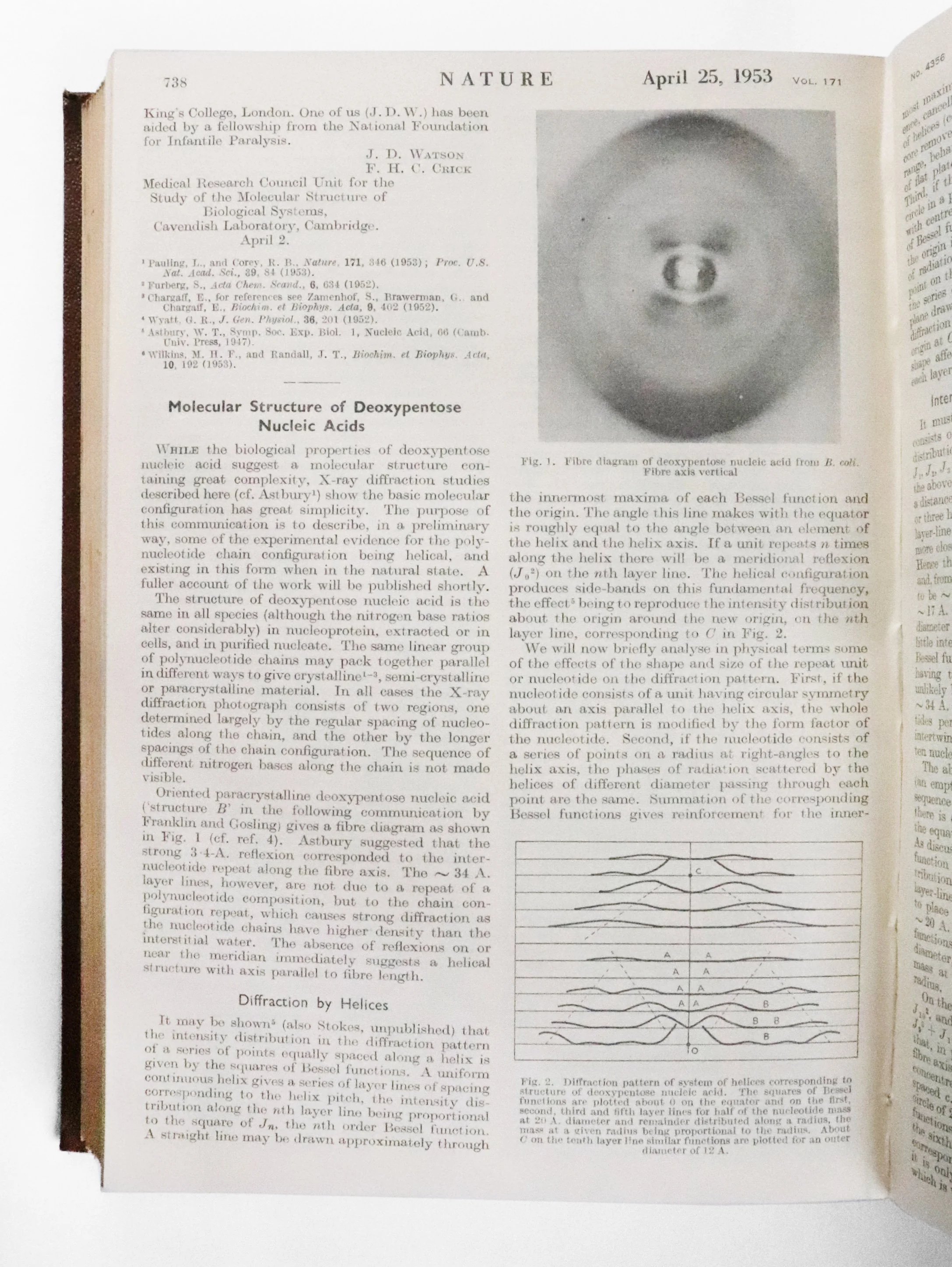THE STRUCTURE OF DNA: THE KEY PAPERS, 1953



THE STRUCTURE OF DNA: THE KEY PAPERS, 1953
ONE OF THE GREATEST STORIES IN THE HISTORY OF SCIENCE: THE RACE TO UNRAVEL THE STRUCTURE OF DNA SOLVED BY...
Watson, J. D. & Crick, F. H. C. 'A structure for deoxyribose nucleic acid', pp. 737–738
Wilkins, M. H. F., Stokes, A. R. & Wilson, H. R. 'Molecular structure of deoxypentose nucleic acids', pp. 738–740
Franklin, R. E. & Gosling, R. G. 'Molecular configuration in sodium thymonucleate', pp. 740–741
Watson, J. D. & Crick, F. H. C. 'Genetical implications of the structure of deoxyribonucleic acid', pp. 964–967
Offered is volume of Nature (171, January–June, 1953) – crucially containing No. 4, 'Genetical implications of the structure of deoxyribonucleic acid', which is not present in the single issue for April or the three-paper offprint often seen on the market.
A landmark in the history of science, and one of a handful of the most important (sets of) papers published in the 20th century. Crick and Watson present their double-helical structure for DNA; Franklin and Gosling present 'Photo 51'; Wilkins publishes the paper that will place him alongside Crick and Watson for the 1962 Nobel Prize (with Franklin having died in 1958); Crick and Watson explore the implications of their discovery.
The longer story of DNA goes back to the 1860s, and the discovery of 'nuclein' by the Swiss physiological chemist Friedrich Miescher. The chemical composition of what came to be called deoxyribonucleic acid was worked out in the early 20th century. Around the same time, new innovations in X-ray crystallography led to the idea of understanding the physical structure of biomolecules.
In 1944 a paper was published by Oswald Avery and his colleagues at Rockefeller University showing that hereditary units, or genes, are composed of DNA. Inspired by this, Erwin Chargaff established his famous 'rules' that govern the ratios of the different nucleic acids.
By the early 1950s a number of research teams – at Cambridge and King's College London – were close to solving exact arrangement in space the DNA molecule. Notoriously, Jim Watson was given a glimpse of Franklin's work by Maurice Wilkins, and this proved to be the final piece of the puzzle: on 25 April 1953 Nature published three papers in issue No. 4356, with Crick and Watson claiming the 'prize' of discovery, and the two King's teams represented by their complementary papers – Franklin's including one of the most famous scientific images ever printed, 'Photo 51'.
Far from being the end of the race, however, this marked just the start of a revotuion in molecular biology. As Crick and Watson wryly commented at the end of their paper:
"It has not escaped our notice that the specific pairing we have postulated immediately suggests a possible copying mechanism for the genetic material."
Their first follow-up paper, 'Genetical implications of the structure of deoxyribonucleic acid' (No. 4 here) is the first contribution to our understanding of the way in which the double-helix structure and arrangement of nucleotides actually replicate and hence lead to the inheritance of genetic material.
Though the story that Crick and Watson ran into the nearby Eagle Pub proclaiming that they had found 'the secret of life' is certainly apocryphal, there is no doubt that all the scientists involved understood the significance of their work. The 1962 Nobel Prize honoured two of the teams – Crick and Watson's, and Wilkins' – and subsequent historians have rightly placed Rosalind Franklin and her colleagues back at the heart of the story.
Very good condition in brown cloth with gilt title. NOT ex library as often. Excellent condition throughout; a clean and bright volume.

